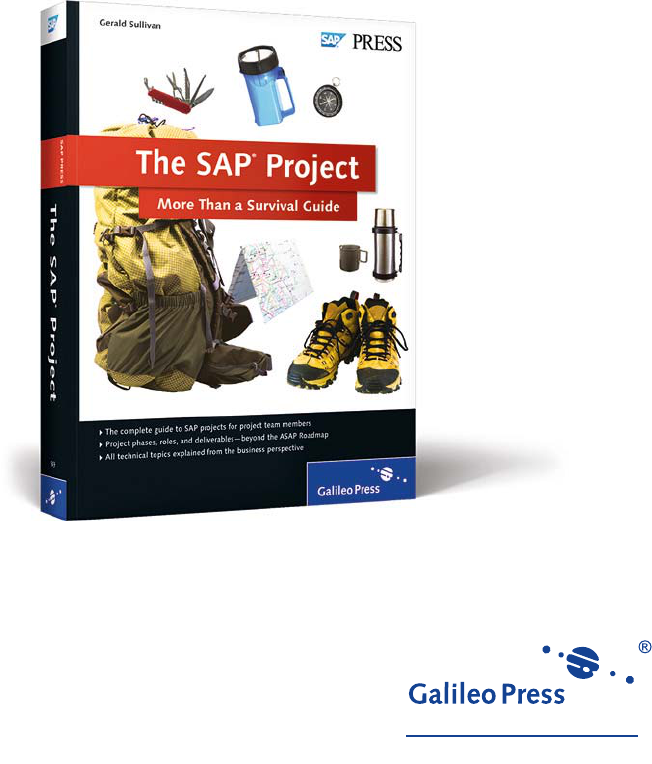
Bonn
폷
Boston
Gerald Sullivan
Project Templates
from
The SAP
®
Project: More Than a Survival Guide

Project Templates
2
Project Templates
The following templates are designed to give you a quick-reference list of the
kinds of information you’ll require for and produce during various project
phases. Each SAP implementation is a little different, so be sure to adapt it to fit
your project!
Blueprint
Blueprint initiates the formal SAP system design. It defines how the company will
use its SAP system and the business process changes that are necessary to accom
-
plish company objectives. This process involves key process experts from major
business functions and applicable regional operations.
The results of blueprinting will guide all subsequent project activities from real-
ization through to go-live and support.
Trail Marker
The timing listed for each segment of downloadable content assumes a three-month
project preparation phase. Thus, blueprint begins in project month four.
All remaining sections in this document increment their timing based on the blueprint
initiation date. Your project scope and complexity may vary considerably. Please feel
free to adjust these end dates based on the unique characteristics of your project.
Inputs
왘 High-level requirements
왘 Functional workstream proposed business process changes
왘 Project charter (or other scope document)
왘 Blueprint workshop schedule and logistics planning
왘 Kick-off session preparations
왘 Initial business process hierarchy
왘 Legacy systems interconnections

Blueprint
3
Tasks
The following tasks should be executed during this stage.
Key Dependencies
왘 Blueprint design sessions must be complete; project sponsors and key execu-
tive must approve the finished blueprint.
왘 All PDDs and related deliverables must be complete and posted to SAP Solu-
tion Manager.
왘 All custom objects must be reviewed and approved prior to project sponsor
blueprint approval.
Deliverables
왘 Organization hierarchy
왘 Detailed level business processes
Task Tool Who? End Date
Business hierarchy review MS SharePoint Global process
owners
Month Four
Organization hierarchy review MS SharePoint Global process
owners
Month Four
Integration points assigned MS SharePoint Integration
management
Month Four
Key design decisions complete MS SharePoint Global process
owners
Month Six
Regional approval of design MS SharePoint PMO Month Six
Change impacts completed SAP Solution Manager Global process
owners
Month Six
Process design documents
(PDDs) complete
SAP Solution Manager Global process
owners
Month Seven
Business controls documents
completed
SAP Solution Manager Global process
owners
Month Seven
Custom objects gaps approved SAP Solution Manager PMO Month Seven
Project Templates
4
왘 To-be design vision
왘 Key design decisions
왘 Change impacts
왘 Key performance indicators (KPIs)
왘 Custom objects gap documents
왘 Process design documents (PDDs)
왘 Business controls documentation
Outcomes
왘 Approved design
왘 Localization initiation
Configuration
Configuration forms one of the two core components in the realization build
phase. During this time, the project team converts blueprint decisions into exe
-
cutable transactions in the SAP system. This process involves key integrator SAP
transaction experts from each global process team.
Configuration sets the stage for the initiation of systems test.
Inputs
왘 Process definition documents (PDDs) with process flows complete
왘 Availability of SAP development system
왘 Availability of SAP Solution Manager Implementation Guide (IMG)
왘 Realization project plan available
왘 Business process hierarchy (BPH) and organization hierarchy approved
왘 Realization kick-off sessions complete
왘 Necessary localizations identified

Configuration
5
Tasks
The following tasks should be executed during this stage.
Key Dependencies
왘 Trained configuration analysts are available.
왘 Documentation standards are defined and approved.
Task Tool Who? End Date
Define configuration cycles MS SharePoint Global process
teams
Month Seven
Assign configuration analysts MS SharePoint Global process
teams
Month Seven
Complete configuration ratio-
nale template
SAP Solution Manager PMO Month Seven
Train configuration analysts MS SharePoint PMO Month Seven
Complete cycle one configura-
tion (organization hierarchy and
major master data)
SAP Solution Manager PMO Month Seven
Complete cycle two configura-
tion (remaining master data)
SAP Solution Manager Global process
owners
Month Eight
Complete cycle three configura-
tion (simple transactions)
SAP Solution Manager Global process
owners
Month Eight
Complete cycle four configura-
tion (complex transactions)
SAP Solution Manager Global process
owners
Month Eight
Complete configuration ratio-
nale specifications
SAP Solution Manager PMO Month Nine
Post configuration rationale
specifications to SAP Solution
Manager
SAP Solution Manager Global process
teams
Month Nine
Review and approve configura-
tion rationale specifications
SAP Solution Manager Global process
teams
Month Nine
Complete configuration func-
tional testing
Test tracking system Test team Month Nine
Project Templates
6
왘 All configuration cycles are clearly identified and scheduled.
왘 Functional test processes and tracking mechanisms are prepared.
Deliverables
왘 Configuration template
왘 Approved configuration rationale specifications
왘 Configuration rationale specification documents posted to SAP Solution Man-
ager
Outcomes
왘 Configuration complete
왘 Configuration functional testing complete
왘 String testing readiness
Custom Objects
Custom object design represents the second core component of the realization
build phase. During this time, the application development team will construct
those WRICEFP objects from the approved gap documents submitted in blue
-
printing.
Custom objects build involves a close working relationship between application
developers and integrator staff assigned to the global process teams. The interplay
between these groups results in functional specifications and successful testing of
each object.
Inputs
왘 Gap documents complete and approved
왘 Process definition documents (PDDs) with process flows complete
왘 Availability of SAP development system
왘 Realization project plan available
왘 Business process hierarchy (BPH) and organization hierarchy approved
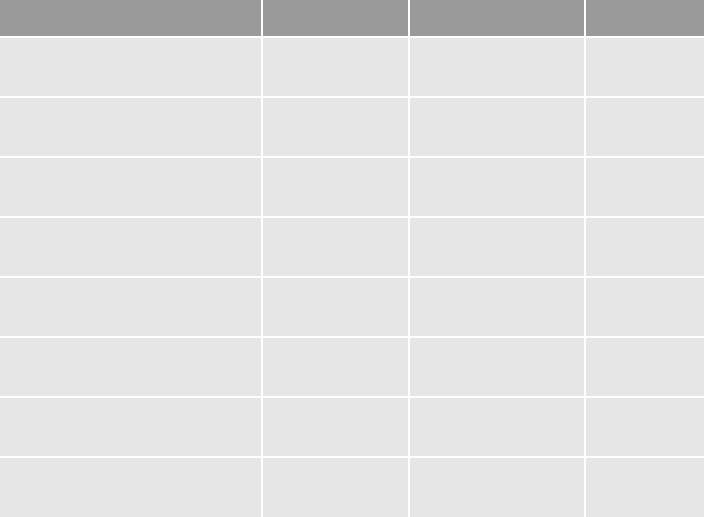
Custom Objects
7
왘 Realization kick-off sessions complete
왘 Necessary localizations identified
Tasks
The following tasks should be executed during this stage.
Key Dependencies
왘 Gap documents are prepared and fully reviewed prior to the start of develop-
ment.
왘 Documentation standards are defined and approved.
왘 Fully staffed applications development team are assigned and on-board.
Deliverables
왘 Functional specification template
Task Tool Who? End Date
Application development team
fully staffed
MS SharePoint Global process
owners
Month Seven
Functional specification tem-
plate prepared and approved
SAP Solution
Manager
Global process
teams
Month Seven
Technical specification template
prepared and approved
SAP Solution
Manager
Application
development team
Month Seven
Functional specifications pre-
pared for each custom object
SAP Solution
Manager
Global process
teams
Month Eight
Technical specifications pre-
pared for each custom object
SAP Solution
Manager
Application
development team
Month Nine
Unit test plans prepared and
approved
MS SharePoint Global process
owners
Month Nine
Unit tests performed and
passed
SAP Solution
Manager
Application
development team
Month Nine
Custom objects reviewed and
approved
SAP Solution
Manager
Global process
owners
Month Nine
Project Templates
8
왘 Technical specification template
왘 Custom object functional specifications
왘 Custom objects technical specifications
왘 Unit test results
Outcomes
왘 Custom object development complete
왘 Unit testing complete
왘 String testing ready for custom object data
Data Conversion
Data conversion transfers needed data from legacy systems into the SAP system.
This data provides required master data to operate the SAP system or historical
transactional records to ensure continuity as part of system change.
Data conversion is a complex process that is accomplished in stages throughout
realization and final preparation. The objective is to achieve accurate and com
-
plete data necessary to run the new SAP system.
Inputs
왘 Full date review
왘 Data definition documents
왘 Availability of a data conversion system (if used)
왘 Fully staffed data team
왘 DEV and QAS systems available
Tasks
The following tasks should be executed during this stage.
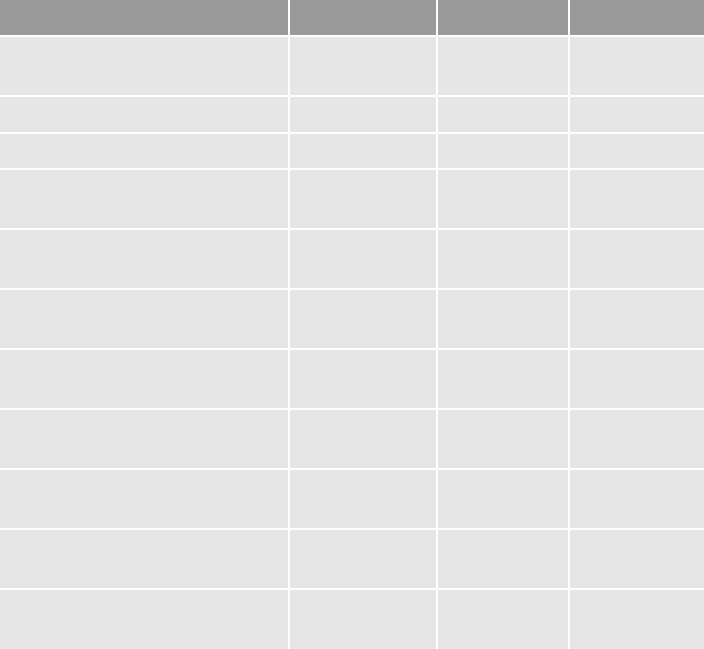
Data Conversion
9
Key Dependencies
왘 Integration and user acceptance testing schedules are aligned with data load
schedules.
왘 Data defects have been resolved prior to completion of testing or production
load.
왘 Testing system is available for data verification usage.
왘 Data owners are available for review and verification tasks.
Deliverables
왘 Integration and user acceptance test data
Task Tool Who? End Date
Define data conversion scope and
processes
MS SharePoint Data team Month Eight
Schedule for iterative loads MS SharePoint Data team Month Eight
Data conversion protocols MS SharePoint Data team Month Eight
Prepare data functional conversion
specifications
SAP Solution
Manager
Data team Month Nine
Cleansing of data from legacy
systems to DEV and QAS
MS Excel Global process
owners
Months Nine
through Fifteen
Complete data extracts Data conversion
tool
Data team Months Nine
through Fifteen
Transform and load legacy data to
the SAP system
Data conversion
tool
Data team Months Nine
through Fifteen
Review and confirm correct data
loads in DEV and QAS
Testing system Global process
owners
Months Nine
through Fifteen
Load legacy data into the SAP
production system
Data conversion
tool
Data team Month
Nineteen
Confirm accuracy of Production
data loads
Testing system Global process
owners
Month
Nineteen
Release data for general use SAP production
system
PMO Month
Nineteen
Project Templates
10
왘 Production data
왘 Approved data conversion scripts
Outcomes
왘 Approved and accurate data in test systems
왘 Approved and accurate data in production system
End User Training
End user training prepares all users to operate the SAP system. Training is built
around role requirements; end users receive training for the transactions that
their roles demand. Training is developed specifically for the system as it is imple
-
mented. Thus, training materials will reflect configuration and custom objects
prepared especially for the company system.
Training developers work closely with the process teams to identify necessary
information for that set of users. In an iterative fashion, developers prepare cur
-
riculum, course outlines, and course materials to fit these requirements. Instruc-
tors are prepared to deliver the material, and administrators track attendance and
course completion.
Inputs
왘 Process definition documents (PDDs)
왘 Configuration specification rationales
왘 Change impacts documents
왘 Project charter (and other scope documents)
Tasks
The following tasks should be executed during this stage.
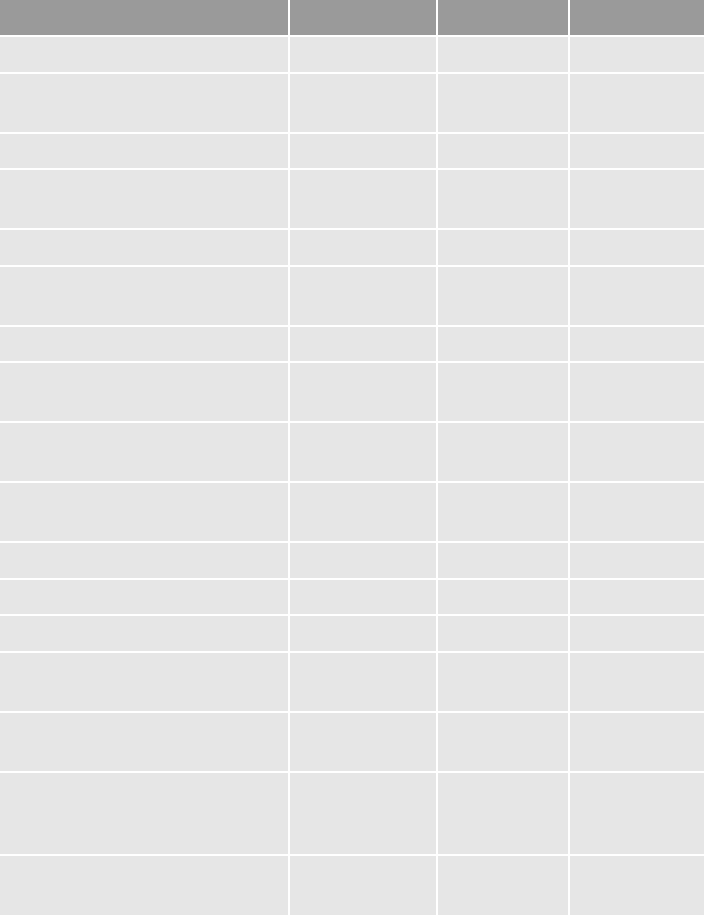
End User Training
11
Task Tool Who? End Date
Fully staffed training team available MS SharePoint PMO Month Six
Assign subject matter experts to
support training developers
MS SharePoint Global process
owners
Month Seven
Course curriculum proposal MS SharePoint Training team Month Seven
Course curriculum approved MS SharePoint Global process
owners
Month Seven
Course outlines submitted MS SharePoint Training team Month Nine
Course outlines approved MS SharePoint Global process
owners
Month Nine
Training material developed MS PowerPoint Training team Month Twelve
Training material reviewed and
approved
MS SharePoint Global process
owners
Month
Thirteen
Course instructors selected MS SharePoint Global process
owners
Month Fifteen
Train-the-trainer sessions sched-
uled
MS Outlook Training team Month Fifteen
Train-the-trainer sessions held MS SharePoint Training team Month Fifteen
Translator vendor selected MS SharePoint Training team Month Fifteen
Training system available MS SharePoint Basis team Month Sixteen
Materials submitted to translation
vendor
MS Outlook Training team Month Sixteen
Materials received from translation
vendor
MS Outlook Training team Month
Seventeen
Classes scheduled and facilities
assigned
Learning
management
system
Training team Month
Seventeen
End user training conducted MS SharePoint Training team Month
Eighteen

Project Templates
12
Key Dependencies
왘 Role mapping is complete and roles are assigned to users.
왘 Training is mapped to roles.
왘 Facilities and infrastructure training requirements are complete.
왘 Instructors are available to conduct classes.
왘 End users are available to attend classes as per schedule.
Deliverables
왘 Curriculum proposal
왘 Course outlines
왘 Completed training materials
왘 Translated materials
왘 Training system
왘 Records of course attendance and completion
Outcomes
왘 Approval to issue SAP UserIDs
왘 Distribution of SAP UserIDs
Integration Testing
Integration testing begins the formal assessment of the configured SAP system. It
permits the project team to verify that system elements, including custom
Ongoing assessment of required
training completion
Learning
management
system
Training team Month
Eighteen
End users who complete training
matched to SAP UserIDs
MS SharePoint Basis team Month
Nineteen
Task Tool Who? End Date

Integration Testing
13
objects, perform as intended. Integration testing confirms that company business
processes operate effectively and that SAP transactions create desired results.
Integration test is often handled by the project systems integrator (assisted by the
core project team) and is divided into two to four separate cycles.
Inputs
왘 Completed custom objects and documentation
왘 Completed configuration and documentation
왘 Functional and unit test completion
왘 Completed string test
왘 Availability of the quality assurance system (QAS)
왘 Availability of selected testing system
Tasks
The following tasks should be executed during this stage.
Task Tool Who? End Date
Integration test entrance review
conducted
MS PowerPoint PMO Month Ten
Test scenarios defined Testing system Test team Month Ten
Test scripts written and reviewed MS SharePoint Global process
owners
Month Ten
Test scripts loaded to testing
system
Testing System Test team Month Ten
Tester team selected MS SharePoint Test team Month Ten
Tester training conducted MS PowerPoint PMO Month Ten
Test data loaded to QAS SAP QAS Data team Month Ten
Complete integration test cycle
one (configuration)
Testing system Global process
owners
Month Eleven
Complete integration test cycle
two (limited custom objects)
Testing system Global process
owners
Month Twelve
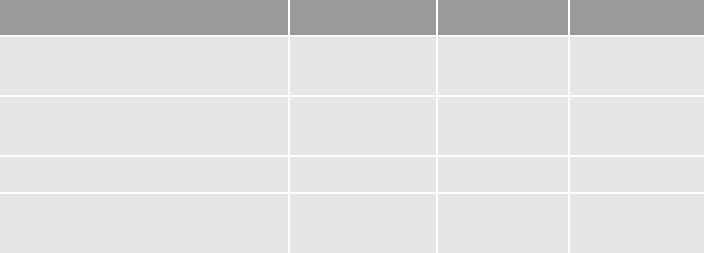
Project Templates
14
Key Dependencies
왘 String test of configuration and custom object must be completed and defects
resolved prior to initiation of integration test.
왘 Project sponsors and key executive must approve entrance into integration
test.
왘 Testing system, if used, must be available and configured for integration test.
왘 Integration test data must be transported to the QAS system prior to initiation
of integration testing.
Deliverables
왘 Test scenarios and test scripts
왘 Test processes
왘 Confirmed system operation
왘 Defect resolution processes
Outcomes
왘 Confirmed design or needed alterations
왘 Preparation for user acceptance test
Complete integration test cycle
three (remaining custom objects)
Testing system Global process
owners
Month
Thirteen
Defect resolution process under-
way
Testing system Test team Month Eleven
Test status tracking underway Testing system Test team Month Eleven
Integration test exit review con-
ducted
MS PowerPoint PMO Month
Thirteen
Task Tool Who? End Date
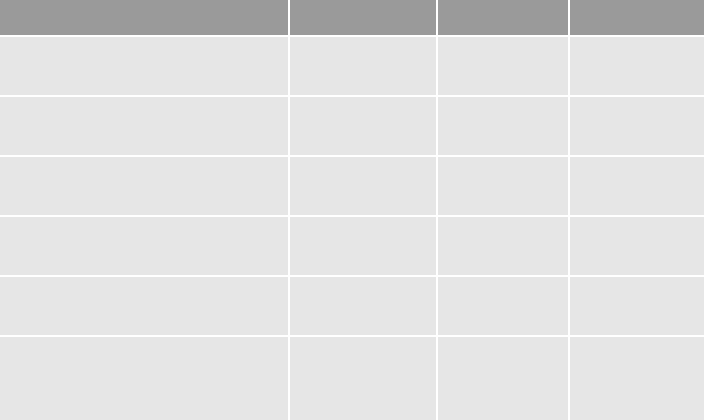
User Acceptance Testing
15
User Acceptance Testing
User acceptance testing concludes the formal assessment of the configured SAP
system. While integration testing confirms that the system operates as designed,
user acceptance testing shows that the system will operate effectively when con
-
ducting company business processes.
User acceptance testing is conducted by company business users. Otherwise, it
may appear very similar to integration testing; in many cases, the same test cycle
structure is used and test scripts may be reused.
Inputs
왘 Integration test exit review approval
왘 Completion of integration test to include resolution of defects
왘 Availability of additional test scripts and scenarios
왘 Availability of user testers
Tasks
The following tasks should be executed during this stage.
Task Tool Who? End Date
User acceptance test entrance
review conducted
MS PowerPoint PMO Month
Fourteen
Test scenarios defined Testing system Test team Month
Thirteen
Test scripts written and reviewed MS SharePoint Global process
owners
Month
Thirteen
Test scripts loaded to testing
system
Testing system Test team Month
Fourteen
User test team selected MS SharePoint Global process
owners
Month
Thirteen
User testers trained on system and
on testing processes
MS PowerPoint Test team and
global process
owners
Month
Thirteen

Project Templates
16
Key Dependencies
왘 The needed user acceptance test data sets are available.
왘 System training material for tester instruction is ready.
왘 Instructors are available for tester system instruction.
왘 Additional test scripts and test scenarios are available.
Deliverables
왘 Completed test scripts
왘 Requirements traceability matrix
왘 System confirmation documentation
Test data loaded to QAS QAS Data team Month
Fourteen
Complete user acceptance test
cycle one (configuration)
Testing system Global process
owners
Month
Fourteen
Complete integration test cycle
two (limited custom objects)
Testing system Global process
owners
Month Fifteen
Complete integration test cycle
three (remaining custom objects)
Testing system Global process
owners
Month Sixteen
Mega-scenario testing completed Testing system Test team and
global process
owners
Month
Seventeen
User acceptance test defect resolu-
tion process underway
Testing system Test team Month
Fourteen
User acceptance test tracking sta-
tus reporting underway
Testing system Test team Month
Fourteen
User acceptance test exit review
conducted and approved
MS PowerPoint PMO Month
Seventeen
Task Tool Who? End Date

Cutover
17
Outcomes
왘 Exit approval from user acceptance test
왘 Confirmed design to fit business processes
왘 Preparation to initiate cutover activities
Cutover
Cutover takes place during the final preparation phase. It represents the last step
prior to go-live and making the system available for general use.
Cutover consists of a number of interrelated steps that must be taken during a
very compressed timeframe. They are intended to ensure that the business is pre
-
pared for the cutover period and the ramp-up time that comes almost immedi-
ately afterwards. Additionally there are a number of system-specific activities that
must be completed in the cutover window.
Inputs
왘 Freeze period identification
왘 Site readiness plans
왘 Regional and site
Tasks
The following tasks should be executed during this stage.
Task Tool Who? End Date
Cutover schedule available MS SharePoint PMO Month
Eighteen
Cutover leads assigned MS SharePoint PMO Month
Eighteen
Regional and site cutover teams
assigned
MS SharePoint Cutover team Month
Eighteen
Freeze plans set for production
sites
MS SharePoint Cutover team Month
Eighteen
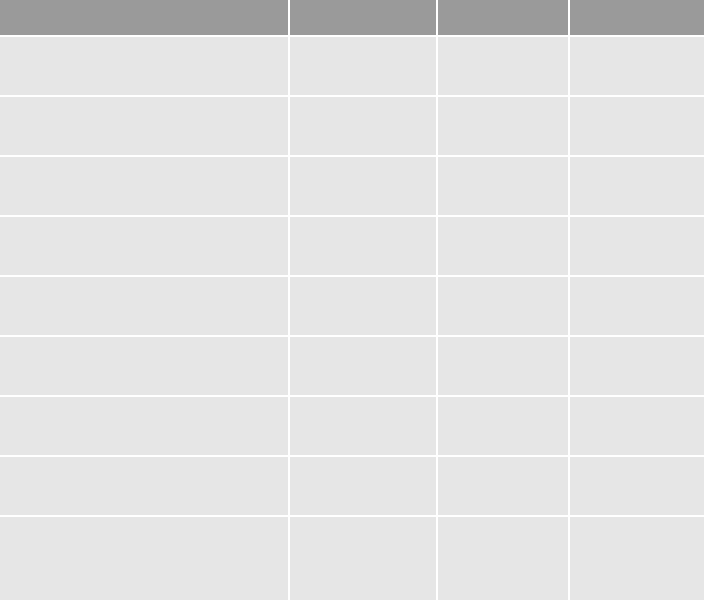
Project Templates
18
Key Dependencies
왘 User acceptance test has been completed.
왘 Approval from project sponsors to move into cutover has been received.
왘 SAP production system is available.
왘 Transports for custom objects and configuration are ready.
왘 Loads of converted data to the production system are ready.
Deliverables
왘 Cutover plan
왘 Ramp-up and ramp down plan
왘 Controlled start plan
Ramp-down plan identified MS SharePoint Cutover team Month
Eighteen
Ramp-up plan and key measures
identified
MS SharePoint Cutover team Month
Eighteen
Data loaded into production SAP system Data team Month
Nineteen
Data verification complete Testing system Data team Month
Nineteen
Custom objects and configuration
transports complete
SAP system Basis team Month
Nineteen
Permission to go live received MS Outlook Project
sponsors
Month
Nineteen
Controlled start underway MS SharePoint Cutover team Month
Nineteen
Ramp-up underway MS SharePoint Cutover team Month
Nineteen
Hypercare period begins Incident
management
system
PMO Month
Nineteen
Task Tool Who? End Date
Cutover
19
왘 Super user support plan
왘 Data load and verification plan
Outcomes
왘 Readiness to go-live
왘 Readiness for system usage
